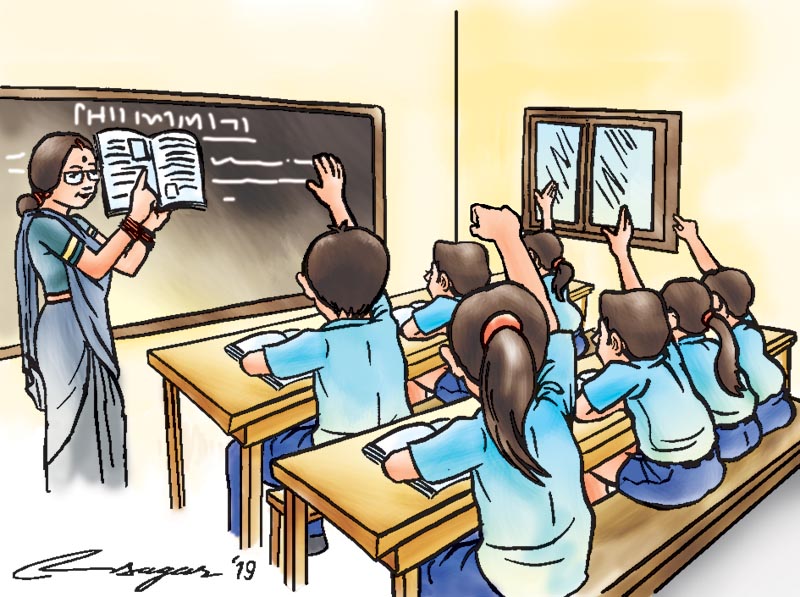Continuous assessment system: From paper to pedagogy
Continuous assessment also calls for individualised instructions to be given to the students of various grade levels in the same class. This runs into practical difficulty if the class size is considerably bigger
The school sector development plan (SSDP), which is currently underway in Nepal, envisions bringing about change in the school education sector by strengthening it in altogether five core dimensions: Equity, quality, efficiency, governance and management, and resilience. As one of the core dimensions is ‘quality’, enhancing the relevance and quality of assessment and examinations is a key output area.
An assessment is ‘the process of gathering, interpreting, recording and using information about a pupil’s responses to educational tasks.’ Understood broadly, students’ appraisal can be done prior to their learning through pre-assessment, during their learning through what is termed as formative assessment and after their learning through summative assessment.
The first two modes of assessment, which fall under the broad framework of continuous assessment of students (CAS), are relatively new and have been introduced in Nepal’s schools with no tangible and observable success. The latter, ever present with variously-known monikers, like final exams, end-term exams, level exams and public exams, still reigns supreme. As cited in the SSDP, although the CAS was introduced in 2009, it is yet to be fully comprehended by parents and teachers to be preferred over summative exams. As regards teachers, one of the problems is that they do not use the CAS to inform how and what they teach, which is its primary function.
And while we still eagerly await the government’s ‘strategic intervention’ to change such a state of affairs, it might be worthwhile to share its implemental ™challenges and how it can be made to work for better learning outcomes through this teacher’s ‘hit and trial’ with CAS.
Continuous assessment also calls for individualised instructions to be given to the students of various grade levels in the same class. This runs into practical difficulty if the class size is considerably bigger. Implementing CAS in a class size of 30 with a good amount of relevant training, ample resources and even with the support of a co-teacher has been quite a challenge for this teacher over the years, although it had positive results nonetheless eventually.
This paradigm shift in assessing students and breakaway from the practice of simply giving them tests requires pre-requisites other than teacher factors like patience, willingness, his/her aptitude and attitude. Such prerequisites include the availability of resources, class-size and teacher training to orient them towards it, curriculum in line with it, examination pattern and parental support, amongst others. Although considered important stakeholders in all these areas, the teachers really do not really have them under their direct purview to bring about any substantial change. In the report by Dr Tirtha Raj Parajuli to the Curriculum Development Centre (CDC) on the effects of CAS on students’ achievement, drop-out and attendance’ in schools where it was piloted in 2003, teachers have blamed the large class size and a mere 5-day training on CAS for its dismal performance.
The SSDP’s ‘strategic intervention’ aims to rectify such structural and systemic deficiencies, and those directly concerned, like parents and teachers, can only hope with cautious optimism that significant changes will be forthcoming by 2022/2023 - the time line it has set for itself to meet its objectives.
Recently when suggestopedia, a language teaching method through a rich sensory learning environment, was being discussed in the class on English language teaching methods, a classmate quipped: ‘We will soon be fired if we introduced such methods in our class!’ The professor rejoined with a befitting reply, ‘Do you teach the students or the curriculum?’ By and large, it’s the curriculum that teachers are compelled to teach and finish to get students through the achievement exams.
How can CAS possibly work if the pre and formative assessments, which are ‘assessments for learning’, designed to enhance and evaluate the skills and competencies of students or to make it more ‘learner-focussed rather than content-focussed’, are again made to be beholden to the same old content-based achievement exams? And even when single subject report cards are prepared, comprising the detailed comments, skill proficiency and recommendations, it’s the sacrosanct single sheet report with scores that parents value. And why wouldn’t they? It’s such numbered reports that matter when they pass out of school.
Until a major restructuring, if not a total overhaul, takes place in the curriculum, examination system and teacher training, which is not limited to the cosmetic five-day affair feeding the egos of the high trainers, CAS practice is best utilised if understood in terms of constantly evaluating the students during learning to prepare them for the achievement exams. When they view their students getting through the summative exams as the predominant or the only marker of their success, training them in a way that aligns the CAS tools they would be using to have a bearing on the students’ examination performance could be a good starting point. This indeed is not what continuous assessment is meant for, but until such a conducive environment is created, CAS could be tapped in this way for better learning outcomes.
Neupane is with Kathmandu University






